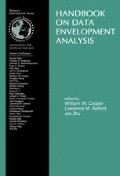Abstract
Duality between distance functions and support functions is shown to be the basis for performance measures and their decompositions. DEA may be used to evaluate the measures.
Access this chapter
Tax calculation will be finalised at checkout
Purchases are for personal use only
Preview
Unable to display preview. Download preview PDF.
References
Chambers, R.G., Y. Chung and R. Färe, 1998, Profit, directional distance functions, and Nerlovian efficiency, Journal of Optimization Theory and Applications 98, 351–364.
Charnes, A., W.W. Cooper and E. Rhodes, 1978, Measuring the efficiency of decision making units, European Journal of Operational Research 2, 429–444.
Debreu, G., 1951, The coefficient of resource utilization, Econometrica 19, 237–292.
Diewert, W.E., 1998, Index number theory using differences rather than ratios, Discussion Paper 98-10 (Department of Economics, University of British Columbia, Vancouver).
Färe, R. and S. Grosskopf, 2000, Theory and application of directional distance functions, Journal of Productivity Analysis 13, 93–103.
Färe, R. and D. Primont, 1995, Multi-output Production and Duality: Theory and Applications, Kluwer Academic Publishers, Boston.
Färe, R. and C.A.K. Lovell, 1978, Measuring the technical efficiency of production, Journal of Economic Theory 19, 150–162.
Farrell, M.J., 1957, The measurement of productive efficiency, Journal of the Royal Statistical Society, Series A, General, 120, Part3, 253–281.
Kemeny, J.G., O. Morgenstern and G.L. Thompson, 1956, A generalization of the von Neumann model of an expanding economy, Econometrica 24, 115–135.
Luenberger, D.G., 1992, New optimality principles for economic efficiency and equilibrium, Journal of Optimization Theory and Applications 75, 221–264.
Luenberger, D.G., 1995, Microeconomic Theory, McGraw Hill, New York.
Mahler, K., 1939, Ein übertragungs prinzip für konvexe körper, Casopis pro Pěstovănl Matematiky a Fusiky 54, 93–102.
Shephard, R.W., 1953, Cost and Production Functions, Princeton University Press, Princeton.
Shephard, R.W., 1970, Theory of Cost and Production Functions, Princeton University Press, Princeton.
Author information
Authors and Affiliations
Editor information
Editors and Affiliations
Rights and permissions
Copyright information
© 2004 Kluwer Academic Publishers
About this chapter
Cite this chapter
Färe, R., Grosskopf, S., Whittaker, G. (2004). Distance Functions. In: Cooper, W.W., Seiford, L.M., Zhu, J. (eds) Handbook on Data Envelopment Analysis. International Series in Operations Research & Management Science, vol 71. Springer, Boston, MA. https://doi.org/10.1007/1-4020-7798-X_5
Download citation
DOI: https://doi.org/10.1007/1-4020-7798-X_5
Publisher Name: Springer, Boston, MA
Print ISBN: 978-1-4020-7797-5
Online ISBN: 978-1-4020-7798-2
eBook Packages: Springer Book Archive

